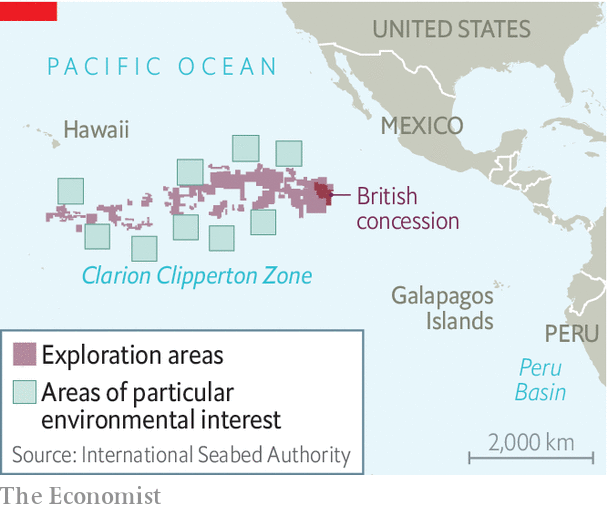DIVA AMON, a researcher at the Natural History Museum in London, spotted her first whale skull in 2013, during an expedition to the Clarion Clipperton Zone (CCZ) in the tropical Pacific. It sat on beige silt, some 4,000 metres beneath the sea’s surface, and was entirely covered in a black coating. Her find was twice notable. First, the skull’s coating meant it was millions of years old, for it was made of the same slowly accumulating metallic oxides as the potato-like ore nodules that are drawing miners to the area. Second, the discovery highlighted how little is known about the deep ocean. Dr Amon’s whale skull, and others like it, raise questions about the trade-offs between the economic gains of mining the seabed and that mining’s environmental consequences.
Those involved in deep-sea mining hope it will turn into a multi-billion-dollar industry. Seabed nodules are dominated by compounds of iron (which is commonplace) and manganese (which is rarer, but not in short supply from mines on dry land). However, the nodules also contain copper, nickel and cobalt, and sometimes other metals such as molybdenum and vanadium. These are in sufficient demand that visiting the bottom of the ocean to acquire them looks a worthwhile enterprise. Moreover, these metals seldom co-occur in terrestrial mines. So, as Kris Van Nijen, who runs deep-sea mining operations at Global Sea Mineral Resources (GSR), a company interested in exploiting the nodules, observes: “For the same amount of effort, you get the same metals as two or three mines on land.”
Hades’ hall
Though their location several kilometres beneath the ocean surface makes the nodules hard to get at in one sense, in another they are easily accessible, because they sit invitingly on the seabed, almost begging to be collected. Most are found on parts of the ocean floor like the CCZ, outside the 200-nautical-mile exclusive economic zones of littoral countries. They thus fall under the purview of the International Seabed Authority (ISA), which has issued 17 exploration licences for such resources. All but one of these licences pertain to the CCZ, an area of about 6m square kilometres east-south-east of Hawaii.

The licensees include Belgium, Britain, China, France, Germany, India, Japan, Russia, Singapore and South Korea, as well as several small Pacific island states. America, which is not party to the United Nations Convention on the Law of the Sea that established the ISA, is not involved directly, but at least one American firm, Lockheed Martin, has an interest in the matter through a British subsidiary, UK Seabed Resources. And people are getting busy. Surveying expeditions have already visited the concessions. On land, the required mining machines are being built and tested. What worries biologists is that if all this busyness does lead to mining, it will wreck habitats before they can be properly catalogued, let alone understood.
The first task, therefore, is to establish what exactly lives down there. At first glance, the CCZ’s abyssal plain does not look of much interest. It is a vast expanse of mud, albeit littered with nodules. But, though life here may not be abundant, it is diverse. Craig Smith, an oceanographer at the University of Hawaii, Manoa, who studies the ocean’s abyssal plain, says that the CCZ contains a greater variety of species than the deep seas off the coasts of California and Hawaii.
Some of the CCZ’s creatures stretch the imagination. There is the bizarre, gelatinous, yellow “gummy squirrel” (pictured), a 50cm-long sea cucumber with a tall, wide tail that may operate like a sail. There are galloping sea urchins that can scurry across the sea floor on long spines, at speeds of several centimetres a second. There are giant red shrimps, measuring up to 40cm long. And there are “Dumbo” octopuses, which have earlike fins above their eyes, giving them an eerie resemblance to a well-known cartoon elephant.
Every expedition brings up species that are new to science, many of them belonging to biological families that are also novel. At a conference in Monterey, California, in September, Dr Smith presented results of a biodiversity survey carried out in the British concession, which sits at the eastern end of the CCZ. Of 154 species of bristle worms the surveyors found, 70% were previously unknown. Dr Smith says the concession may be part of a biodiversity hotspot, one which would not be represented in the nine protected areas of environmental interest that have been set aside in the CCZ. He therefore argues for the establishment of a tenth such area, on the margins of the concession.
A whale of a tale
The ocean’s largest inhabitants may also be visitors to the CCZ. This summer Leigh Marsh of Britain’s National Oceanography Centre, in Southampton, described more than 3,000 large depressions in the mud there. These formed a series of curved tracks. Similar tracks elsewhere have been linked to whales scraping themselves against the seafloor. Dr Marsh and her colleagues suggest that deep-diving whales may be foraging on the CCZ seafloor, using it as a giant loofah to scrape parasites from their skins or even ingesting the nodules as ballast. If true, this would significantly extend the depth to which whales are known to dive.
The only direct evidence of whales in the CCZ, though, comes in fossil form. In Monterey, Dr Amon set the audience buzzing when she presented preliminary data suggesting that the region contains large deposits of fossil whale bones. Such fossils were first noted by the Challenger expedition, a world-spanning investigation of the deep ocean conducted in the 1870s by a British naval research vessel. Dr Amon’s find back in 2013 prompted her and her colleagues to go through tens of thousands of images gathered by various exploration submarines. These recorded 548 cetacean fossils from a range of species. Among the oldest was Choneziphius, an extinct animal that lived more than 10m years ago.
Although this work was a study of photographs, rather than of the remains directly, which could cast doubt over some of the identifications, the metallic-oxide coating of many of the bones gives a sense of how old they are. Because of the density of fossils, Dr Amon says the CCZ may be a previously undiscovered, and rare, submarine fossil bed.
Why whale fossils would accumulate in this particular spot is unknown. Possibly, those elsewhere are simply buried. The CCZ sits beneath the ocean’s clearest waters, so its sediments accumulate extremely slowly. But it may be that some as-yet-unknown physical process is keeping the fossils and the (equally old) nodules at the surface of the silt. Indeed, why the nodules are exposed is one of the great mysteries of the region. Regardless, Dr Smith, Dr Amon and others hope the bones’ presence will be taken into account as the ISA drafts the rules and regulations for exploitation of the CCZ.
Whale fossils, sea cucumbers and shrimps are just the stuff that is visible to the naked eye. Adrian Glover, one of Dr Amon’s colleagues at the Natural History Museum, and his collaborators spent weeks peering down microscopes, inspecting every nook and cranny of the surfaces of some of the nodules themselves. They discovered a miniature ecosystem composed of things that look, at first sight, like flecks of colour—but are, in fact, tiny corals, sponges, fan-like worms and bryozoans, all just millimetres tall. In total, the team logged 77 species of such creatures, probably an underestimate.
Out of sight. Out of mind?
Inevitably, much of this life will be damaged by nodule mining. The impacts are likely be long-lasting. Deep-sea mining technology is still in development, but the general idea is that submersible craft equipped with giant vacuum cleaners will suck nodules from the seafloor. Those nodules will be carried up several kilometres of pipes back to the operations’ mother ships, to be washed and sent on their way.
The size and power of the submersibles means that they will leave large tracks in their wake. These are likely to persist for a long time. Evidence for this comes from various decades-old disturbance experiments. In 2015 an exploratory expedition by IFREMER, a French government agency responsible for oceanography, noted that even mobile animals like sea urchins were 70% less abundant within 37-year-old experimental tracks than outside them.
The largest disturbance experiment so far was carried out in 1989 in the Peru Basin, a nodule field to the south of the Galapagos Islands. An eight-metre-wide metal frame fitted with ploughs and harrows was dragged back and forth repeatedly across the seabed, scouring it and wafting a plume of sediment into the water. In 2015 a research vessel returned to the site. Down went the robots, samplers and submarines with their scanners and cameras. The big question was, 26 years after the event, would the sea floor have recovered? The answer was a resounding “no”. The robots brought back images of plough tracks that looked fresh, and of wildlife that had not recovered from the decades-old intrusion.
Another concern, in the wake of the Peru Basin experiment, is sediment. This will be both stirred up during collection, as the robots crawl across the sea floor and hoover it, and washed off the nodules at the surface when they are cleaned. Ideally, a second pipe would deliver those washings directly back to the seabed, in order to keep disruption in the water column to a minimum. In practice, dumping silt overboard will be much easier. Decades of failure to police overfishing demonstrate how hard it is to regulate activity on the high seas.
If silt were dumped in this way it could be disastrous. A steady stream of the stuff raining down from the surface would affect everything along the way, especially filter-feeding animals such as sponges and krill, which make their livings by extracting small particles of food floating in the water. The effect both in the water column and on the sea floor might not be so great in other parts of the oceans, say biologists, but life in the crystalline CCZ is wholly unadapted to murky waters.
All of this needs to be balanced against the impacts of mining the equivalent amounts of minerals on land, however. The CCZ covers about 2% of the deep ocean. A 20-year operation within it would affect of the order of 10,000 square kilometres—about a six-hundredth of its area—according to Mr Van Nijen. And, unlike mining developments in virgin areas of dry land, which tend to bring other forms of development in their wake by creating transport links that encourage human settlement, no one is going to follow the nodule-hoovers and actually live on the abyssal plain.
In the end, the only way to measure how mining would change the bottom of the ocean may be to conduct small-scale pilot operations. The first will take place next April, when GSR will lower Patania II, an enormous green tractor, to the bed of the CCZ. Patania II is a prototype nodule collector. It will clear areas roughly 300 by 100 metres, leaving them nodule-free, so that future expeditions can return and study recolonisation rates. An array of sensors suspended in the nearby water will monitor the resultant silt plume, which the company’s models suggest could travel up to 5km—not the hundreds of kilometres that some have suggested.
To scrutinise this trial independently, JPI Oceans, an intergovernmental research body, has paid for the Sonne, a German research vessel, to sail alongside GSR’s. As Mr Van Nijen puts it, “We need to validate our equipment, but from an environmental perspective, the world’s first mining test at depth is a unique opportunity for scientists to study the impacts. If we don’t do this in a transparent manner, it will go nowhere.” That sounds like a promising start. But however careful the miners are, life for the inhabitants of the CCZ is about to get a lot less peaceful than it has been for millions of years.










